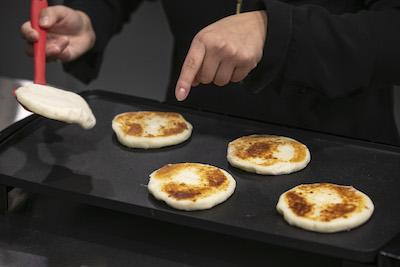
Food helps people experience other cultures, said Kerri LaCharite, a nutrition and food studies assistant professor in George Mason University’s College of Health and Human Services. LaCharite teaches NUTR 583 Food and Culture, where students learn how the many different facets of culture—globalization, identity, gender, race, socio-economic status, religion and hunger—affect eating behaviors.
Topics in the course include the symbolism of meal structures and patterns, how food served as a locus of oppression and liberation for African Americans in the aftermath of slavery, and the role of food in preserving cultures.
Students also pick a particular country or sub-culture to explore and even conduct primary interviews with people about the culture there.
“Students must demonstrate a recipe, and then we all get to interact and try it and taste it,” LaCharite said.

“One of my dear friends was born and raised in Ethiopia, and she lives in the U.S. now,” said Marissa A. Rollins, a student in the master of public health program. “I had the opportunity to talk to her about her food in her culture, and she shared a recipe with me that I ended up actually cooking for my fellow classmates.”
Rollins prepared shiro, which she describes as a chickpea stew. Many Ethiopian dishes are served with injera, a spongy, stretchy sour bread that is often used as a utensil, she added.
“A lot of Ethiopian food is served family style, so you’ll have a very big plate with injera on the bottom and different dishes put on top,” said Rollins. “And it’s a lot of vegetarian-based dishes,” Rollins said.
For his cooking demonstration, graduate student Anthony (Tony) Santos, whose family is from Colombia, made arepas, a corn- and cheese-based flat pancake, and changua, a white soup served with an egg.
“In the class, we talked about how certain cultures think of certain foods to be extra nutritious, help with being sick, or help fight certain diseases,” said Santos, who plans to graduate with a master’s degree program in nutrition in May 2022. “I made changua because I want people to see this is something we discussed in class—these concepts of food that we think are actually more nutritious than they actually are.”
Another student who was studying Japan made tofu burgers, LaCharite said, by draining and kneading the tofu and mixing in onions and carrots. “I learn something new every time,” she said.
At the end of the semester, students are challenged to come up with their own food rules.
“You think about what’s your food identity and what taboos do you hold,” said Rollins. “For example, I won’t eat dogs, cats, or bugs. It’s this new way of thinking that I got from this course.”
